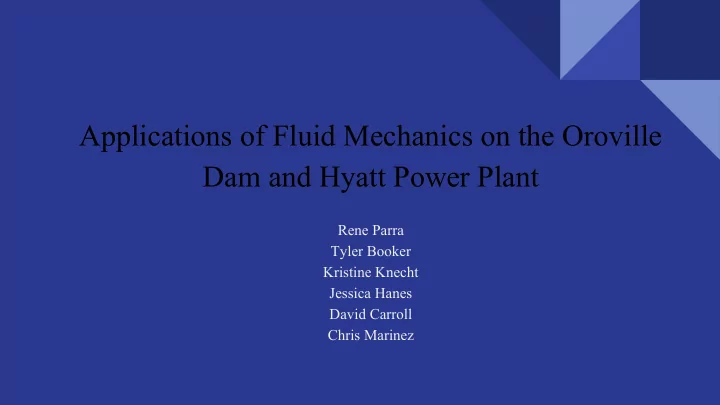

Applications of Fluid Mechanics on the Oroville Dam and Hyatt Power Plant Rene Parra Tyler Booker Kristine Knecht Jessica Hanes David Carroll Chris Marinez
Oroville Dam ● East of the Sacramento Valley Built in 1963-1968 ● Tallest dam in the US at 770 ft high ● ● Serves for water supply, flood control and hydroelectricity generation
Hyatt Powerplant ● Building occurred through 1964-1967 Underground, hydroelectric ● Pumps and Generators ● ● Focusing on the combined Pump Generators Maximizes power by returning excess ● water to the Lake Oroville ● Brought in through penstocks
Research Question 1: How has the drought affected the hydrostatic force acting on the Oroville dam? Hypothesis: By treating the dam as a flat trapezoid, an integral can be created in order to calculate the different hydrostatic forces as the depth changes.
Hydrostatic Force ● By differentiating both sides of the force equation, the following integral is formed
First step was to draw dam and get dimensions ● Crest length is 6920 ft ● Base height was assumed to be 3460 ft by inspection ● Dam height is 770 ft
Next step was putting dA in terms of y Finding BC in terms of y in order to find length AB with respect to y
AC=2BC+3460 AC=2(2.25y)+3460 ft dA=4.49y+3460 dy
Putting together the final integral
Final Force
Dam depth before and after drought Dam in December 2015 was 520 ft Dam in March 2016 was at 732 ft
Difference in Force before and after the Drought Before the drought the force was 3.58 x 10 10 lbs After the drought the force was 7.62 x 10 10 lbs This results in a 112% increase
Research Question 2: Why is a trapezoidal shape a more logical and economical decision for a dam versus a rectangular shape? Hypothesis: A trapezoidal dam shape makes more intuitive sense over a rectangular shape because it mirrors a standard hydrostatic pressure distribution curve. By application of the hydrostatic equation we find that the pressure force is a function of depth. The dam is going to undergo a maximum force at the base of the dam according to this equation and decrease proportional to the thickness of the dam with a trapezoidal shape. A rectangular shape has a constant thickness which doesn’t work well with the changing magnitude of the hydrostatic force.
Hydrostatic Equation: Rectangular
Force from the Weight of the Structure: Rectangular
Resultant Force: Rectangular
Trapezoidal Details
Depth of Centroid
Hydrostatic Equation: Trapezoidal
Force from the Weight of the Structure: Trapezoidal
Resultant Force: Trapezoidal
Resultant Force: Rectangular vs Trapezoidal
Research Question 3: Is it possible to lessen the head loss through the pumps in the Oroville Dam and Hyatt Powerplant? Hypothesis and approach: The power equation and Bernoulli’s Equation ● Givens are researched and found ● ● Adjustments are made for the best head loss ● Reasoning used to eliminate unrealistic solutions
The Power Equation ● 3 pumps, each with Q ● Gravity is 32.2 ft/s^2 ● Density of water is 1.94 slugs/ft^3 ● Power output is 97.4*10^6 ft*lb/s ● Flow Rate is 2,800 ft^3/s Pump head = 556.9 ft (per pump)
Bernoulli’s Equation With the pump head, Bernoulli’s ● equation can be applied to find the head loss ● Assume position 1 is at the top of the reservoir, exposed to air ● Position 2 is located at the beginning of the river
Bernoulli’s Equation Position 1: Position 2: Pressure at surface = 0 psf ● Pressure at point 2 = ρgh = 374.8 psf ● ● Velocity at surface = 0 ft/s ● Velocity at point 2 = Q/A = 7.37 ft/s Height at surface = 770 ft ● Height at point 2 = -6 ft ● ● Gravity = 32.2 ft/s^2 ● Density = 62.24 lb/ft^3 Pump Head = 556.9 ft ● Head Loss = 1,140 ft
Factors Affecting Head Loss ● Flow Rate: Higher velocity → higher head loss Pipe Diameter: Larger diameter → less friction → less head loss ● ● Roughness of Pipe Wall: Smoother surface → less friction → less head loss Length of the Pipe: Longer Pipe → more friction → more head loss ● ● Straightness of the Pipe: More bends → more friction → more head loss
Conclusions ● The depth of the dam varies by about 480 ft before and after the drought This results in a 112% increase in the Hydrostatic Force ● Trapezoidal shape is the better choice economically and structurally ● ● Not many realistic solutions to reduce head loss other than: -decreasing flow rate -changing depth of the water
Recommend
More recommend